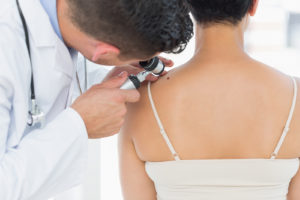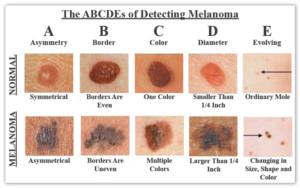Skin cancer is the most common form of cancer in the United States. It is one of the few types of cancer that affects people regardless of age, gender, or race. There are three different types of skin cancer: basal-cell carcinoma, squamous-cell carcinoma, and perhaps the most widely-known type, melanoma.
The first two types are, by far, the most common forms of skin cancer. These two forms, while serious, do not typically spread. The third form, melanoma, is infamous because of its tendency to spread cancer throughout other areas of the body.
A common belief about skin cancer is that it’s caused by exposing unprotected skin to the harmful UV rays of the sun. While in most cases this belief is true, there have been cases of skin cancer that were not brought on by the sun. Skin cancer is actually a mutation that happens in the DNA in the cells of the skin. Some people have skin cancer in parts of the body not typically exposed to the sun. The cause can be due to genetics, a weakened immune system, or exposure to toxic substances in their environment.
General symptoms for any type of skin cancer include:
- Openings or cuts in the skin that do not heal
- Changes in any mole or skin growth, especially regarding color or size
Protect and Reduce Your Risk of Skin Cancer
Protection from ultraviolet (UV) radiation is important all year round, not just during the summer or at the beach. UV rays from the sun can reach you on cloudy and hazy days, as well as bright and sunny days. UV rays also reflect off of surfaces like water, cement, sand and snow. Indoor tanning (using a tanning bed, booth or sunlamp to get tan) exposes users to UV radiation and causes skin wrinkling.
The hours between 10 a.m. and 4 p.m. Daylight Saving Time are the most hazardous for UV exposure outdoors in the continental United States. UV rays from sunlight are the greatest during the late spring and early summer in North America.
Prevent!
The Centers for Disease Control (CDC) recommends that you…
- Stay in the shade, especially during midday hours.
- Wear clothing that covers your arms and legs.
- Wear a hat with a wide brim to shade your face, head, ears, and neck.
- Wear sunglasses that wrap around and block both UVA and UVB rays.
- Use sunscreen with sun protective factor (SPF) 15 or higher, and
- Avoid indoor tanning.
Mistakes Happen
Sunburn hurts, peels and inflicts wrinkle-inducing damage. But mistakes happen. So, if you should happen to get a sunburn, treat it right!
- If you see your skin reddening or feel tingling, get out of the sun immediately. Sunburn can sneak up on you and may take 4 to 6 hours to develop.
- Moisturize sunburned skin with a lotion containing Vitamin E to lessen peeling.
- Sunburn draws fluid to the skin surface and away from the rest of the body, so drink extra water, juice and sports drinks for a couple of days.
- Take ibuprophen for swelling and redness especially in the first 48 hours. Ibuprophen also may prevent long-term skin damage.
- In some cases, if blistering covers 20% or more of your body, seek medical attention.








Thank you for this interesting information.